It is one of the most gripping scenes in Neil Jordan’s movie "Michael Collins". Liam Neeson, as Michael Collins, entered the Dublin Metropolitan Police station on Great Brunswick (now Pearse) Street at midnight on April 7, 1919. He’s there to read the Royal Irish Constabulary’s files on the rebels—and maybe a particular rebel named Michael Collins.
Michael Collins’ Dublin
Many of the addresses that Collins used around Dublin are still extant. There’s the building at 29 Parnell Square, formerly Vaughan’s Hotel—Collins’ “Joint Number One”—stands today as an apartment building with a historic plaque that somehow fails to mention it was Collins’ favorite hangout.
Two of his favorite pubs, the Stag’s Head, on Dame Court, and Cleary’s Pub at 36 Amiens Street, just opposite Connolly Station, are still in operation today. A stroll down Exchequer Street and its extension, Wicklow Street, will reveal Collins’ first office at 10 Exchequer Street, another favorite pub The Old Town sits at 37 Exchequer. Further along Wicklow Street at 4, near Weir & Sons jewelry store on the corner of Grafton Street, sits an AIB branch that was once the Wicklow Hotel, another Collins haunt.
Now added to that historic list is the back door to the Pearse Street Garda station on Townsend Street. It was through this back door that Collins entered and exited for his thrilling adventure on April 7th.
The plaque in both Irish and English reads:
“On April 7, 1919, during the Irish War of Independence, Michael Collins, future Commander-in-Chief of the Irish Defence Forces, Óglaigh na hÉireann was smuggled through this door into the Dublin Metropolitan Police Headquarters, Great Brunswick Police Station now Pearse Street Garda Station, by Detective Sergeant Eamon Broy D.M.P. who was subsequently appointed as the third Commissioner of An Garda Síochána in 1933.”
An intelligence coup
In his eponymous biography of Collins, Tim Pat Coogan wrote, “Broy smuggled him [Collins] into Detective Headquarters in Brunswick Street, where he spent the night going through the ‘G’ Division records. As with many of the turning points in his life, he approached the escapade in a ‘light-hearted’ fashion. Encountering his old Frongoch companion, Sean Nunan, en route, he impulsively brought him along ‘for the crack.’ Nunan, who later became a director of the Irish Press, told me about the Brunswick St. visit on more than one occasion. His abiding memory was the fright he got during the small hours of the morning when a drunk broke a window in their wing, and he feared that the police would come to inspect the damage. however, they dealt with the offender, a soldier, without coming near Broy’s sanctum.”
Collins' light heart grew dark when he gleaned the intelligence: “Nunan remembered,” Coogan wrote, “Collins chuckling over the contents of his own file which began, ‘He comes from a brainy family.’ But the Brunswick St. experience was no laughing matter.
Collins had had the entire modus operandi of the Royal Irish Constabulary’s intelligence system laid out before him. He saw both what he was up against and how to combat his enemy, the first Irish revolutionary to do so. Initially, he gave no sign of the importance of the discovery, turning up at the following day’s Dáil [Irish parliament] sitting ‘with no great sign of fatigue considering his busy, sleepless night.’ ”
The lessons of Brunswick Street
What Collins learned that night had a dramatic effect on how he would plan his war on British Intelligence. Within days, according to Coogan “he took the first steps towards implementing the lessons of Brunswick St. Acting on his orders, a number of ‘G’ men were accosted by Volunteers and warned against an access of zeal. ‘G’ men who did not comply would pay for their stubborn courage with their lives, thus inaugurating a new and bloodier phase of the Anglo-Irish struggle.”
Collins also got to view phone logs from the Easter Rising in which he learned that some of the very people who he thought were loyal to the Republican cause were, in fact, in cahoots with the British. Desperate measures were needed.
A month later, in May 1919, Eamon de Valera left for an eighteen-month sojourn of his own—to America. That vacuum was immediately filled by his devoted Minister for Finance, one Michael Collins. By July an Active Service Unit was formed to take care of ambitious “G” men. In time they would be known in legend as Collins’ “Twelve Apostles.”
By September the Squad had its first victim, Detective Sergeant Patrick Smyth who had been terrorizing the Volunteers with his reckless élan since the Rising.
By the spring he was joined in death by the spy called Jameson and bank inspector Alan Bell, a long-time British agitator who had been at the Irish since the days of the Land League. His sin? He had confiscated £18,000 of Collins’ National Loan money from a bank in Dame Street. After Bell’s demise, there were no other bank examiners rushing to Dublin looking for National Loan money. The carnage continued until November 21, 1920—Bloody Sunday—when the Squad executed fourteen British spies.
Twelve months and 16 days later, an Irish nation was born.
So, what started out as a “light-hearted” romp for Collins, turned into one of his earliest coups as Director of Intelligence of the IRA. Now, at the back door of the Pearse Street Garda Station on Townsend Street, you can trace the steps of the Dublin Pimpernel, General Michael Collins, on that fateful night.
* Dermot McEvoy is the author of "The 13th Apostle: A Novel of Michael Collins" and the "Irish Uprising and Real Irish New York: A Rogue’s Gallery of Fenians, Tough Women, Holy Men, Blasphemers, Jesters, and a Gang of Other Colorful Characters". He is also the author of "Our Lady of Greenwich Village", all now available from Skyhorse Publishing. He may be reached at [email protected]. Follow him at www.dermotmcevoy.com. Follow The 13th Apostle on Facebook.




Comments